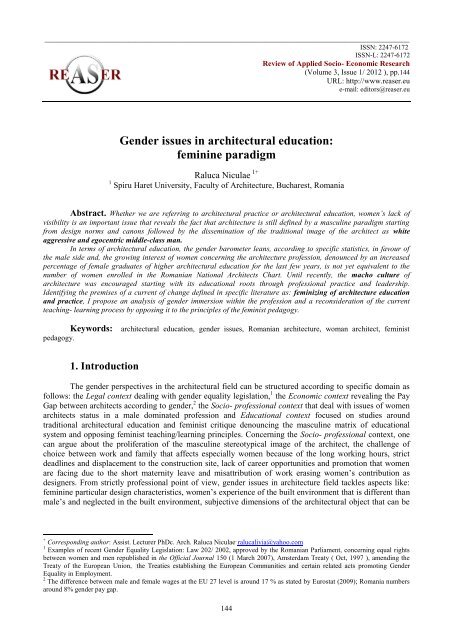Volume 3, ISSUE1/2012 - Review of Applied Socio-Economic ...
Volume 3, ISSUE1/2012 - Review of Applied Socio-Economic ...
Volume 3, ISSUE1/2012 - Review of Applied Socio-Economic ...
Create successful ePaper yourself
Turn your PDF publications into a flip-book with our unique Google optimized e-Paper software.
________________________________________________________________________________________________<br />
ISSN: 2247-6172<br />
ISSN-L: 2247-6172<br />
<strong>Review</strong> <strong>of</strong> <strong>Applied</strong> <strong>Socio</strong>- <strong>Economic</strong> Research<br />
(<strong>Volume</strong> 3, Issue 1/ <strong>2012</strong> ), pp.144<br />
URL: http://www.reaser.eu<br />
e-mail: editors@reaser.eu<br />
Gender issues in architectural education:<br />
feminine paradigm<br />
Raluca Niculae 1+<br />
1 Spiru Haret University, Faculty <strong>of</strong> Architecture, Bucharest, Romania<br />
Abstract. Whether we are referring to architectural practice or architectural education, women’s lack <strong>of</strong><br />
visibility is an important issue that reveals the fact that architecture is still defined by a masculine paradigm starting<br />
from design norms and canons followed by the dissemination <strong>of</strong> the traditional image <strong>of</strong> the architect as white<br />
aggressive and egocentric middle-class man.<br />
In terms <strong>of</strong> architectural education, the gender barometer leans, according to specific statistics, in favour <strong>of</strong><br />
the male side and, the growing interest <strong>of</strong> women concerning the architecture pr<strong>of</strong>ession, denounced by an increased<br />
percentage <strong>of</strong> female graduates <strong>of</strong> higher architectural education for the last few years, is not yet equivalent to the<br />
number <strong>of</strong> women enrolled in the Romanian National Architects Chart. Until recently, the macho culture <strong>of</strong><br />
architecture was encouraged starting with its educational roots through pr<strong>of</strong>essional practice and leadership.<br />
Identifying the premises <strong>of</strong> a current <strong>of</strong> change defined in specific literature as: feminizing <strong>of</strong> architecture education<br />
and practice, I propose an analysis <strong>of</strong> gender immersion within the pr<strong>of</strong>ession and a reconsideration <strong>of</strong> the current<br />
teaching- learning process by opposing it to the principles <strong>of</strong> the feminist pedagogy.<br />
pedagogy.<br />
Keywords:<br />
architectural education, gender issues, Romanian architecture, woman architect, feminist<br />
1. Introduction<br />
The gender perspectives in the architectural field can be structured according to specific domain as<br />
follows: the Legal context dealing with gender equality legislation, 1 the <strong>Economic</strong> context revealing the Pay<br />
Gap between architects according to gender, 2 the <strong>Socio</strong>- pr<strong>of</strong>essional context that deal with issues <strong>of</strong> women<br />
architects status in a male dominated pr<strong>of</strong>ession and Educational context focused on studies around<br />
traditional architectural education and feminist critique denouncing the masculine matrix <strong>of</strong> educational<br />
system and opposing feminist teaching/learning principles. Concerning the <strong>Socio</strong>- pr<strong>of</strong>essional context, one<br />
can argue about the proliferation <strong>of</strong> the masculine stereotypical image <strong>of</strong> the architect, the challenge <strong>of</strong><br />
choice between work and family that affects especially women because <strong>of</strong> the long working hours, strict<br />
deadlines and displacement to the construction site, lack <strong>of</strong> career opportunities and promotion that women<br />
are facing due to the short maternity leave and misattribution <strong>of</strong> work erasing women’s contribution as<br />
designers. From strictly pr<strong>of</strong>essional point <strong>of</strong> view, gender issues in architecture field tackles aspects like:<br />
feminine particular design characteristics, women’s experience <strong>of</strong> the built environment that is different than<br />
male’s and neglected in the built environment, subjective dimensions <strong>of</strong> the architectural object that can be<br />
+ Corresponding author: Assist. Lecturer PhDc. Arch. Raluca Niculae , ralucalivia@yahoo.com<br />
1 Examples <strong>of</strong> recent Gender Equality Legislation: Law 202/ 2002, approved by the Romanian Parliament, concerning equal rights<br />
between women and men republished in the Official Journal 150 (1 March 2007), Amsterdam Treaty ( Oct, 1997 ), amending the<br />
Treaty <strong>of</strong> the European Union, the Treaties establishing the European Communities and certain related acts promoting Gender<br />
Equality in Employment.<br />
2 The difference between male and female wages at the EU 27 level is around 17 % as stated by Eurostat (2009); Romania numbers<br />
around 8% gender pay gap.<br />
144








